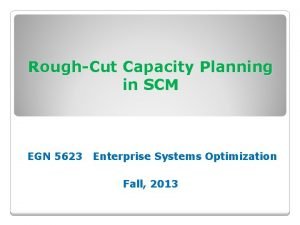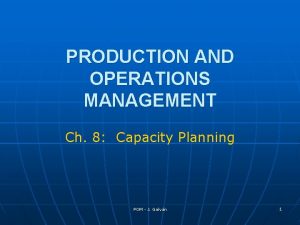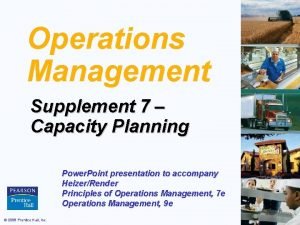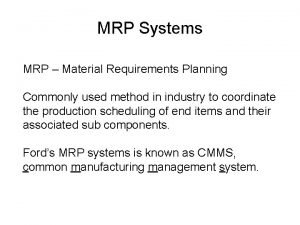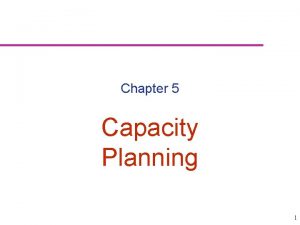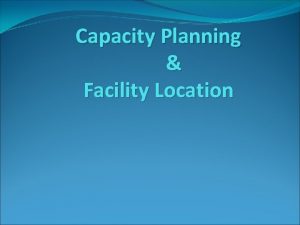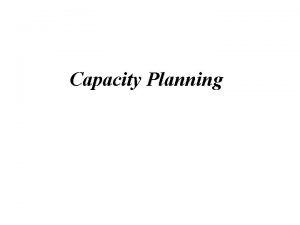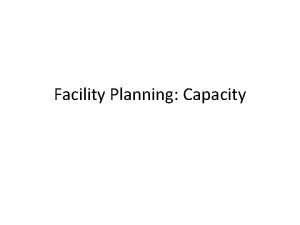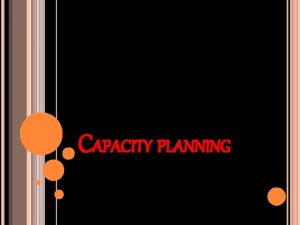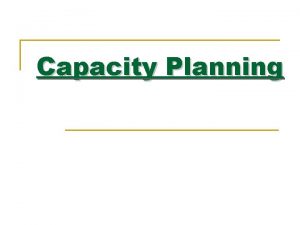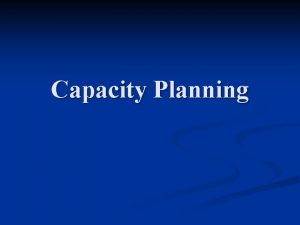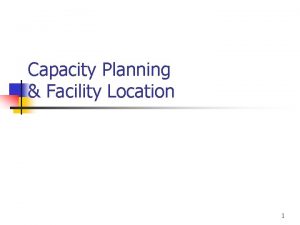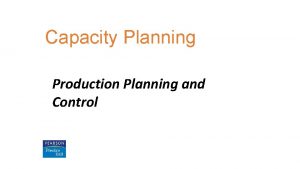Capacity Planning Chapter 5 What is Capacity Capacity












- Slides: 12

Capacity Planning Chapter #5

What is Capacity? Capacity is the ability of a process or system to hold, receive, store or accommodate. In business terms, it is the amount of output that a system is capable of achieving over a period of time. › E. g. in service set-ups, it is the number of customers handled in a day or time of a day. › In manufacturing firms the no. of units which can be produced in a single shift.

What is Capacity? Capacity is related to the time dimension. i. e. it is stated relative to some time period. Such as: › Long term capacity › Intermediate capacity › Short term capacity The concept of capacity varies over type of business and nature of process under consideration.

Capacity Planning Capacity is planned at different levels, and it has a different meaning for different people, e. g. › The GM of a production unit will plan for over all capacity of all the plants producing a single product. › A production manager will consider capacity of a single plant. › A shift manager will be concerned with capacity of a single shift in a plant etc. Accounting, finance, marketing, operations, purchasing, and human resources all need capacity information to make decisions.

Capacity Planning It is important for any firm to plan for capacity as too little capacity or too much capacity is dangerous for business. Too little capacity means a low output, which means lost customer sales and not able to meet demand. Too much capacity means wastage of resources and extra cost of operations as well as access supply of goods, increasing inventory costs.

Measures of Capacity Utilization §Output measures of capacity: §Capacity can be measured in terms of final goods produced in a day or week, e. g. no. of cars produced in a day. §Useful for firm who produce standardized product with little variety or customization. §Input measures of capacity §Used for low volume, flexible processes such as producing furniture. §Here the capacity can be measured in terms of no. of labor hours and no. of workers needed etc. §Utilization: Degree to which equipment, space or work force is currently being used, is measured as the ratio of average output rate to max. capacity. Average output rate Utilization = 100% Maximum capacity

Capacity Planning (long-term) Economies of scale › › 1. 2. 3. 4. Spreading fixed costs Reducing construction costs Cutting costs of purchased materials Finding process advantages Diseconomies of scale u Complexity u Loss Please see page 266 (book-1)for details of focus u Inefficiencies

Average unit cost (dollars per patient) Capacity and Scale 250 -bed hospital 500 -bed hospital Economies of scale Diseconomies of scale Output rate (patients per week) Figure 5. 1 – Economies and Diseconomies of Scale 750 -bed hospital

Capacity Timing and Sizing Strategies Sizing capacity cushions › Capacity cushions are the amount of reserve capacity a process uses to handle sudden changes › It measures the amount by which the average utilization falls below 100 percent. Capacity cushion = 100% – Average Utilization rate (%)

Capacity Timing and Sizing Strategies Please see page 269 (book-1)for details Expansionist strategy › Involves large, infrequent expansions in capacity. Wait-and-see strategy › Involves smaller and more frequent expansion in capacity.

(a) Expansionist strategy Forecast of capacity required Capacity Planned unused capacity Capacity increment Time between increments Time

(b) Wait-and-see strategy Capacity Planned use of short-term options Forecast of capacity required Capacity increment Time between increments Time
 Aggregate planning is capacity planning for:
Aggregate planning is capacity planning for: Aggregate capacity planning
Aggregate capacity planning Examples of aggregate planning
Examples of aggregate planning Production units have an optimal rate of output where
Production units have an optimal rate of output where Vmware capacity planner
Vmware capacity planner Rough cut capacity plan
Rough cut capacity plan Planned capacity
Planned capacity Leading demand with incremental expansion
Leading demand with incremental expansion What is rough cut capacity planning
What is rough cut capacity planning Mainframe capacity planning
Mainframe capacity planning San capacity planning
San capacity planning Collaborative capacity planning
Collaborative capacity planning Capacity planning in cloud computing
Capacity planning in cloud computing





